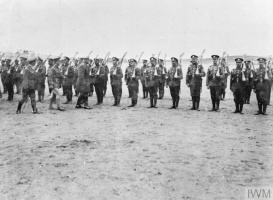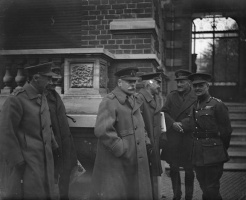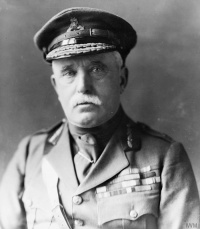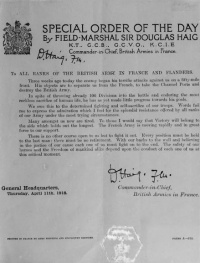Functions and Structure↑
During the war, the British established General Headquarters on the Western Front, at the Dardanelles, in Egypt, Mesopotamia, Africa, Salonika, Italy, and in Russia.[1] Each GHQ managed an expeditionary force, which ranged in size from several brigades in Russia to five armies in the case of the BEF. In addition to commanding the expeditionary force in a particular theater, each GHQ linked that force with the British government, reporting to the War Office in London. The only exceptions were those expeditionary forces dispatched from India to Mesopotamia and East Africa in 1914, which initially reported to the Commander-in-Chief of the Army in India. By 1916, however, these forces also reported directly to the War Office. Each GHQ also served as a link between British and Allied forces operating in a particular theater. This was particularly important in the final year of the war on the Western Front, when all British and French forces were placed under the control of French commander Ferdinand Foch (1851-1929). Structurally, each GHQ was divided into three principal branches. The General Staff branch was responsible for the collection of intelligence as well as the planning and conduct of operations. The Adjutant-General’s branch managed discipline, medical and sanitary services. The Quartermaster’s Branch was responsible for supplying the army. Also attached to GHQ were individual officers who were not part of a specific branch, such as the Officer Commanding Royal Artillery, the Engineer-in-Chief and the Deputy Judge Advocate-General.
GHQ on the Western Front↑
Given the duration and scale of operations in which it was involved, the largest and most complex General Headquarters was that of the British Expeditionary Force (BEF) on the Western Front. Under the command of Sir John French (1852-1925) in 1914-1915, and Sir Douglas Haig (1861-1928) from 1916 until November 1918, this organization has been examined far more extensively by historians than its counterparts in other theaters. Understanding its evolution from 1914-1918 is key to understanding the performance of the British army on the Western Front. At the outset of the war, the General Staff branch of GHQ faced significant difficulties controlling subordinate formations during mobile operations. But the stabilization of the Western Front in late 1914 brought new challenges. As the BEF began conducting offensive operations against formidable German defenses, GHQ had difficulty supplying and coordinating subordinate formations. Its failure to deploy reserve divisions to support the operations of the First Army at the Battle of Loos in September 1915 was in fact a key factor in the removal of Sir John French as commander-in-chief at the end of the year. Under Sir Douglas Haig, the performance of GHQ did not immediately improve. While Haig chose capable officers to fill key staff positions, their personal loyalty to him diminished their ability to challenge the preconceptions of the commander-in-chief. After British offensives in 1917 failed to meet expectations, two of these officers, the Chief of the General Staff, Launcelot Kiggell (1862-1954), and the Chief of Intelligence, John Charteris (1877-1946), were both removed from their positions.
As the war progressed, however, GHQ became less involved in the planning and conduct of operations, for two reasons. First, the growing size of the BEF made it increasingly difficult for Haig and his staff to control the movements of specific corps and divisions on a daily basis. Secondly, the emergence of capable army and corps commanders with extensive operational experience made the direct participation of GHQ unnecessary. In 1917 and even moreso in 1918, GHQ took on an increasingly managerial role, setting general objectives and providing resources at the request of army and corps commanders, but allowing subordinate formations to manage the conduct of day-to-day operations.
Nikolas Gardner, UAE National Defense College
Section Editor: Jennifer Wellington
Notes
- ↑ The opinions expressed in this article are those of the author and do not reflect the views of the National Defense College, or the United Arab Emirates government.
Selected Bibliography
- Boff, Jonathan: Winning and losing on the Western Front. The British Third Army and the defeat of Germany in 1918, Cambridge; New York 2012: Cambridge University Press.
- Brown, Ian M.: British logistics on the Western Front, 1914-1919, Westport 1998: Praeger.
- Fox, Frank: G. H. Q. (Montreuil-sur-Mer), London 1920: P. Allan & Co.
- Harris, J. P.: Douglas Haig and the First World War, Cambridge; New York 2008: Cambridge University Press.
- Prior, Robin / Wilson, Trevor: Command on the Western Front. The military career of Sir Henry Rawlinson 1914-1918, Barnsley 2004: Leo Cooper.
- Travers, Timothy: The killing ground. The British Army, the Western Front, and the emergence of modern warfare, 1900-1918, London; Boston 1987: Allen & Unwin.











